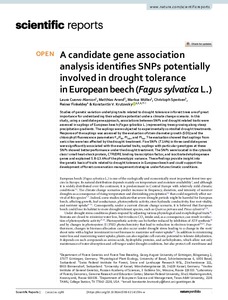A candidate gene association analysis identifies SNPs potentially involved in drought tolerance in European beech (Fagus sylvatica L.)
Скачать файл:
URI (для ссылок/цитирований):
https://elib.sfu-kras.ru/handle/2311/137962Автор:
Cuervo-Alarcon L.
Arend M.
Müller M.
Sperisen C.
Finkeldey R.
Krutovsky K.V.
Дата:
2021Журнал:
Scientific ReportsКвартиль журнала в Scopus:
даСтатья из журнала.
Аннотация:
Studies of genetic variation underlying traits related to drought tolerance in forest trees are of great importance for understanding their adaptive potential under a climate change scenario. In this study, using a candidate gene approach, associations between SNPs and drought related traits were assessed in saplings of European beech (Fagus sylvatica L.) representing trees growing along steep precipitation gradients. The saplings were subjected to experimentally controlled drought treatments. Response of the saplings was assessed by the evaluation of stem diameter growth (SDG) and the chlorophyll fluorescence parameters FV/FM, PIabs, and PItot. The evaluation showed that saplings from xeric sites were less affected by the drought treatment. Five SNPs (7.14%) in three candidate genes were significantly associated with the evaluated traits; saplings with particular genotypes at these SNPs showed better performance under the drought treatment. The SNPs were located in the cytosolic class I small heat-shock protein, CTR/DRE binding transcription factor, and isocitrate dehydrogenase genes and explained 5.8–13.4% of the phenotypic variance. These findings provide insight into the genetic basis of traits related to drought tolerance in European beech and could support the development of forest conservation management strategies under future climatic conditions. © 2021, The Author(s).
Studies of genetic variation underlying traits related to drought tolerance in forest trees are of great importance for understanding their adaptive potential under a climate change scenario. In this study, using a candidate gene approach, associations between SNPs and drought related traits were assessed in saplings of European beech (Fagus sylvatica L.) representing trees growing along steep precipitation gradients. The saplings were subjected to experimentally controlled drought treatments. Response of the saplings was assessed by the evaluation of stem diameter growth (SDG) and the chlorophyll fluorescence parameters FV/FM, PIabs, and PItot. The evaluation showed that saplings from xeric sites were less affected by the drought treatment. Five SNPs (7.14%) in three candidate genes were significantly associated with the evaluated traits; saplings with particular genotypes at these SNPs showed better performance under the drought treatment. The SNPs were located in the cytosolic class I small heat-shock protein, CTR/DRE binding transcription factor, and isocitrate dehydrogenase genes and explained 5.8–13.4% of the phenotypic variance. These findings provide insight into the genetic basis of traits related to drought tolerance in European beech and could support the development of forest conservation management strategies under future climatic conditions. © 2021, The Author(s). Studies of genetic variation underlying traits related to drought tolerance in forest trees are of great importance for understanding their adaptive potential under a climate change scenario. In this study, using a candidate gene approach, associations between SNPs and drought related traits were assessed in saplings of European beech (Fagus sylvatica L.) representing trees growing along steep precipitation gradients. The saplings were subjected to experimentally controlled drought treatments. Response of the saplings was assessed by the evaluation of stem diameter growth (SDG) and the chlorophyll fluorescence parameters FV/FM, PIabs, and PItot. The evaluation showed that saplings from xeric sites were less affected by the drought treatment. Five SNPs (7.14%) in three candidate genes were significantly associated with the evaluated traits; saplings with particular genotypes at these SNPs showed better performance under the drought treatment. The SNPs were located in the cytosolic class I small heat-shock protein, CTR/DRE binding transcription factor, and isocitrate dehydrogenase genes and explained 5.8–13.4% of the phenotypic variance. These findings provide insight into the genetic basis of traits related to drought tolerance in European beech and could support the development of forest conservation management strategies under future climatic conditions. © 2021, The Author(s).

